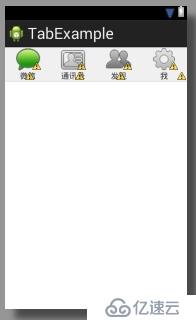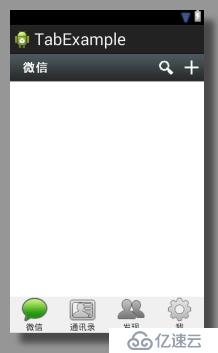小编给大家分享一下Android如何实现仿微信底部菜单栏+顶部菜单栏,希望大家阅读完这篇文章之后都有所收获,下面让我们一起去探讨吧!
采用ViewPage来做,每一个 page对应一个XML,当手指在ViewPage左右滑动时,就相应显示不同的page(其实就是xml)并且同时改变底部菜单按钮的图片变暗或变亮, 同时如果点击底部菜单按钮,左右滑动page(其实就是xml)并且改变相应按钮的亮度。
最终效果:×××

一、布局
1、顶部菜单布局,命名为top_layout.xml,放在layout文件夹下
<?xml version="1.0" encoding="utf-8"?> <RelativeLayout xmlns:android="http://schemas.android.com/apk/res/android" android:layout_width="match_parent" android:layout_height="45dp" android:background="@drawable/title_bar" > <TextView android:layout_width="wrap_content" android:layout_height="wrap_content" android:layout_marginLeft="20dp" android:text="微信" android:layout_centerVertical="true" android:textColor="#ffffff" android:textSize="20sp" android:textStyle="bold" /> <ImageButton android:id="@+id/top_add" android:layout_width="wrap_content" android:layout_height="wrap_content" android:background="@drawable/top_add" android:layout_centerVertical="true" android:layout_alignParentRight="true" /> <ImageButton android:id="@+id/top_search" android:layout_width="wrap_content" android:layout_height="wrap_content" android:background="@drawable/top_search" android:layout_centerVertical="true" android:layout_toLeftOf="@id/top_add" /> </RelativeLayout>
效果:

2、底部菜单布局bottom_layout.xml
<?xml version="1.0" encoding="utf-8"?> <LinearLayout xmlns:android="http://schemas.android.com/apk/res/android" android:layout_width="match_parent" android:layout_height="60dp" android:background="@drawable/bottom_bar" android:orientation="horizontal" > <LinearLayout android:id="@+id/id_tab_weixin" android:layout_width="0dp" android:layout_height="match_parent" android:layout_weight="1" android:gravity="center" android:orientation="vertical" > <!-- android:clickable="false" 是为了防止ImageButton截取了触摸事件 ,这里事件要给它的上一级linearlayout--> <ImageButton android:id="@+id/id_tab_weixin_img" android:layout_width="wrap_content" android:layout_height="wrap_content" android:background="#00000000" android:clickable="false" android:src="@drawable/tab_weixin_pressed" /> <TextView android:layout_width="wrap_content" android:layout_height="wrap_content" android:text="微信" /> </LinearLayout> <LinearLayout android:id="@+id/id_tab_address" android:layout_width="0dp" android:layout_height="match_parent" android:layout_weight="1" android:gravity="center" android:orientation="vertical" > <ImageButton android:id="@+id/id_tab_address_img" android:layout_width="wrap_content" android:layout_height="wrap_content" android:background="#00000000" android:clickable="false" android:src="@drawable/tab_address_normal" /> <TextView android:layout_width="wrap_content" android:layout_height="wrap_content" android:text="通讯录" /> </LinearLayout> <LinearLayout android:id="@+id/id_tab_frd" android:layout_width="0dp" android:layout_height="match_parent" android:layout_weight="1" android:gravity="center" android:orientation="vertical" > <ImageButton android:id="@+id/id_tab_frd_img" android:layout_width="wrap_content" android:layout_height="wrap_content" android:background="#00000000" android:clickable="false" android:src="@drawable/tab_find_frd_normal" /> <TextView android:layout_width="wrap_content" android:layout_height="wrap_content" android:text="发现" /> </LinearLayout> <LinearLayout android:id="@+id/id_tab_settings" android:layout_width="0dp" android:layout_height="match_parent" android:layout_weight="1" android:gravity="center" android:orientation="vertical" > <ImageButton android:id="@+id/id_tab_settings_img" android:layout_width="wrap_content" android:layout_height="wrap_content" android:background="#00000000" android:clickable="false" android:src="@drawable/tab_settings_normal" /> <TextView android:layout_width="wrap_content" android:layout_height="wrap_content" android:text="我" /> </LinearLayout> </LinearLayout>
效果:

3、整体布局
将上面两个加到activity_main.xml中去
<LinearLayout xmlns:android="http://schemas.android.com/apk/res/android" xmlns:tools="http://schemas.android.com/tools" android:layout_width="match_parent" android:layout_height="match_parent" android:orientation="vertical" > <include layout="@layout/top_layout" /> <android.support.v4.view.ViewPager android:id="@+id/id_viewpage" android:layout_width="fill_parent" android:layout_height="0dp" android:layout_weight="1" > </android.support.v4.view.ViewPager> " <include layout="@layout/bottom_layout" /> </LinearLayout>
效果:

效果还可以,底下菜单栏是有背景的,有点儿白色的,所以看得不是很清,一来微信是选中的
4、定义ViewPage的四个布局
因为要用ViewPage要加四个page,每个page对应一个xml,所以这里定义四个xml.
tab01.xml
<?xml version="1.0" encoding="utf-8"?> <LinearLayout xmlns:android="http://schemas.android.com/apk/res/android" android:layout_width="match_parent" android:layout_height="match_parent" android:gravity="center" android:orientation="vertical" > <TextView android:layout_width="wrap_content" android:layout_height="wrap_content" android:text="这里是微信" android:layout_centerVertical="true" android:textColor="#000000" android:textSize="40sp" android:textStyle="bold" /> </LinearLayout>
效果:

tab02.xml
<?xml version="1.0" encoding="utf-8"?> <LinearLayout xmlns:android="http://schemas.android.com/apk/res/android" android:layout_width="match_parent" android:layout_height="match_parent" android:gravity="center" android:orientation="vertical" > <TextView android:layout_width="wrap_content" android:layout_height="wrap_content" android:text="这里是通讯录" android:layout_centerVertical="true" android:textColor="#000000" android:textSize="40sp" android:textStyle="bold" /> </LinearLayout>
效果:效果和上面一样,只是文字改了一下
tab03.xml
<?xml version="1.0" encoding="utf-8"?> <LinearLayout xmlns:android="http://schemas.android.com/apk/res/android" android:layout_width="match_parent" android:layout_height="match_parent" android:gravity="center" android:orientation="vertical" > <TextView android:layout_width="wrap_content" android:layout_height="wrap_content" android:text="这里是发现" android:layout_centerVertical="true" android:textColor="#000000" android:textSize="40sp" android:textStyle="bold" /> </LinearLayout>
效果:效果和上面一样,只是文字改了一下
tab04.xml
<?xml version="1.0" encoding="utf-8"?> <LinearLayout xmlns:android="http://schemas.android.com/apk/res/android" android:layout_width="match_parent" android:layout_height="match_parent" android:gravity="center" android:orientation="vertical" > <TextView android:layout_width="wrap_content" android:layout_height="wrap_content" android:text="这里是我" android:layout_centerVertical="true" android:textColor="#000000" android:textSize="40sp" android:textStyle="bold" /> </LinearLayout>
效果:效果和上面一样,只是文字改了一下
二、代码
1. MainActivity中把控件和ViewPage初始化
package com.example.tabexample;
import java.util.ArrayList;
import java.util.List;
import android.os.Bundle;
import android.app.Activity;
import android.support.v4.view.PagerAdapter;
import android.support.v4.view.ViewPager;
import android.support.v4.view.ViewPager.OnPageChangeListener;
import android.view.LayoutInflater;
import android.view.View;
import android.view.ViewGroup;
import android.view.Window;
import android.widget.ImageButton;
import android.widget.LinearLayout;
public class MainActivity extends Activity implements
android.view.View.OnClickListener {
private ViewPager mViewPager;// 用来放置界面切换
private PagerAdapter mPagerAdapter;// 初始化View适配器
private List<View> mViews = new ArrayList<View>();// 用来存放Tab01-04
// 四个Tab,每个Tab包含一个按钮
private LinearLayout mTabWeiXin;
private LinearLayout mTabAddress;
private LinearLayout mTabFrd;
private LinearLayout mTabSetting;
// 四个按钮
private ImageButton mWeiXinImg;
private ImageButton mAddressImg;
private ImageButton mFrdImg;
private ImageButton mSettingImg;
@Override
protected void onCreate(Bundle savedInstanceState) {
super.onCreate(savedInstanceState);
requestWindowFeature(Window.FEATURE_NO_TITLE);
setContentView(R.layout.activity_main);
initView();
initViewPage();
initEvent();
}
private void initEvent() {
mTabWeiXin.setOnClickListener(this);
mTabAddress.setOnClickListener(this);
mTabFrd.setOnClickListener(this);
mTabSetting.setOnClickListener(this);
mViewPager.setOnPageChangeListener(new OnPageChangeListener() {
/**
*ViewPage左右滑动时
*/
@Override
public void onPageSelected(int arg0) {
int currentItem = mViewPager.getCurrentItem();
switch (currentItem) {
case 0:
resetImg();
mWeiXinImg.setImageResource(R.drawable.tab_weixin_pressed);
break;
case 1:
resetImg();
mAddressImg.setImageResource(R.drawable.tab_address_pressed);
break;
case 2:
resetImg();
mFrdImg.setImageResource(R.drawable.tab_find_frd_pressed);
break;
case 3:
resetImg();
mSettingImg.setImageResource(R.drawable.tab_settings_pressed);
break;
default:
break;
}
}
@Override
public void onPageScrolled(int arg0, float arg1, int arg2) {
}
@Override
public void onPageScrollStateChanged(int arg0) {
}
});
}
/**
* 初始化设置
*/
private void initView() {
mViewPager = (ViewPager) findViewById(R.id.id_viewpage);
// 初始化四个LinearLayout
mTabWeiXin = (LinearLayout) findViewById(R.id.id_tab_weixin);
mTabAddress = (LinearLayout) findViewById(R.id.id_tab_address);
mTabFrd = (LinearLayout) findViewById(R.id.id_tab_frd);
mTabSetting = (LinearLayout) findViewById(R.id.id_tab_settings);
// 初始化四个按钮
mWeiXinImg = (ImageButton) findViewById(R.id.id_tab_weixin_img);
mAddressImg = (ImageButton) findViewById(R.id.id_tab_address_img);
mFrdImg = (ImageButton) findViewById(R.id.id_tab_frd_img);
mSettingImg = (ImageButton) findViewById(R.id.id_tab_settings_img);
}
/**
* 初始化ViewPage
*/
private void initViewPage() {
// 初妈化四个布局
LayoutInflater mLayoutInflater = LayoutInflater.from(this);
View tab01 = mLayoutInflater.inflate(R.layout.tab01, null);
View tab02 = mLayoutInflater.inflate(R.layout.tab02, null);
View tab03 = mLayoutInflater.inflate(R.layout.tab03, null);
View tab04 = mLayoutInflater.inflate(R.layout.tab04, null);
mViews.add(tab01);
mViews.add(tab02);
mViews.add(tab03);
mViews.add(tab04);
// 适配器初始化并设置
mPagerAdapter = new PagerAdapter() {
@Override
public void destroyItem(ViewGroup container, int position,
Object object) {
container.removeView(mViews.get(position));
}
@Override
public Object instantiateItem(ViewGroup container, int position) {
View view = mViews.get(position);
container.addView(view);
return view;
}
@Override
public boolean isViewFromObject(View arg0, Object arg1) {
return arg0 == arg1;
}
@Override
public int getCount() {
return mViews.size();
}
};
mViewPager.setAdapter(mPagerAdapter);
}
/**
* 判断哪个要显示,及设置按钮图片
*/
@Override
public void onClick(View arg0) {
switch (arg0.getId()) {
case R.id.id_tab_weixin:
mViewPager.setCurrentItem(0);
resetImg();
mWeiXinImg.setImageResource(R.drawable.tab_weixin_pressed);
break;
case R.id.id_tab_address:
mViewPager.setCurrentItem(1);
resetImg();
mAddressImg.setImageResource(R.drawable.tab_address_pressed);
break;
case R.id.id_tab_frd:
mViewPager.setCurrentItem(2);
resetImg();
mFrdImg.setImageResource(R.drawable.tab_find_frd_pressed);
break;
case R.id.id_tab_settings:
mViewPager.setCurrentItem(3);
resetImg();
mSettingImg.setImageResource(R.drawable.tab_settings_pressed);
break;
default:
break;
}
}
/**
* 把所有图片变暗
*/
private void resetImg() {
mWeiXinImg.setImageResource(R.drawable.tab_weixin_normal);
mAddressImg.setImageResource(R.drawable.tab_address_normal);
mFrdImg.setImageResource(R.drawable.tab_find_frd_normal);
mSettingImg.setImageResource(R.drawable.tab_settings_normal);
}
}代码量很短,只有几百行,功能就可以实现了,注意这里去掉程序原本的标题栏我直接用了
2、效果:

三、思路说明
1、分别为顶部菜单栏和底部菜单栏新建一个布局
2、中间是ViewPage,然后里面放四个Page(tab01-tab04.xml),注意,要通过适配器给ViewPage提供内容.
3、监听ViewPage和底部菜单栏按钮的事件(注意,这里的按钮放在一个LinearLayout中,所以我们监听了LinearLayout的触摸事件,而屏蔽了Imgaebutton的触摸事件)
4、
public void onClick(View arg0)
这里面监听的是底部菜单的触摸事件,根据触摸的控件,改变自身的亮度、改变ViewPage显示的内容
mViewPager.setOnPageChangeListener(new OnPageChangeListener()
这里监听的是ViewPage左右滑动的事件,改变相应控件的亮度、改变ViewPage显示的内容四、不足之处
1、最新版微信上应该是左右滑动是有部分亮度变化的,这里直接转变过去了。
2、最新版微信文字也要跟着变化,这里没做改变
解决方法:底部的图片渐变 ,可以调整两张重叠图片的透明度来实现。
看完了这篇文章,相信你对“Android如何实现仿微信底部菜单栏+顶部菜单栏”有了一定的了解,如果想了解更多相关知识,欢迎关注亿速云行业资讯频道,感谢各位的阅读!
免责声明:本站发布的内容(图片、视频和文字)以原创、转载和分享为主,文章观点不代表本网站立场,如果涉及侵权请联系站长邮箱:is@yisu.com进行举报,并提供相关证据,一经查实,将立刻删除涉嫌侵权内容。